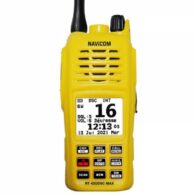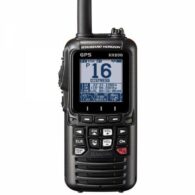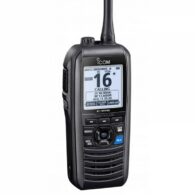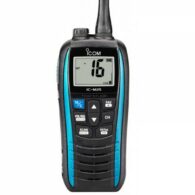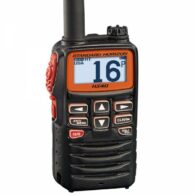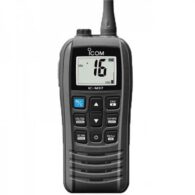Sommaire
I) VHF Portable Marine
II) La technologie ASN
III) Les caractéristiques d’une VHF portable
IV) VHF portable : la législation
V) Des utilisations diverses
VI) La VHF marine portable chez Comptoir Nautique
LE guide d'achat des vhf portables
Obligatoire, ou facultative, selon votre programme de navigation, la VHF marine portable est, quoi qu’il en soit, un élément de sécurité important sur votre bateau. Des plus basiques aux plus performantes, avec ou sans ASN, GPS ou AIS, indépendante ou couplée à la VHF fixe ; les modèles et les déclinaisons foisonnent, nous laissant devant un choix pléthorique de VHF à tous les prix, ainsi, difficile de faire le bon choix.
Nous allons, dans ce guide, tenter de vous aiguiller, de vous informer et de vous aider à choisir votre future VHF portable.
Qu’est-ce qu’une VHF marine portable ? Que dit la réglementation sur la VHF ? Quels avantages possède une VHF portable ? Quelles sont les différentes options que proposent les radios portables ? Quel modèle de VHF portable est la plus adaptée à votre utilisation et vos besoins ?
Autant de questions que nous tenterons d’éclairer ici.
Si vous voulez tout savoir sur la radio VHF marine fixe , consultez notre guide dédié « Choisir sa VHF fixe«
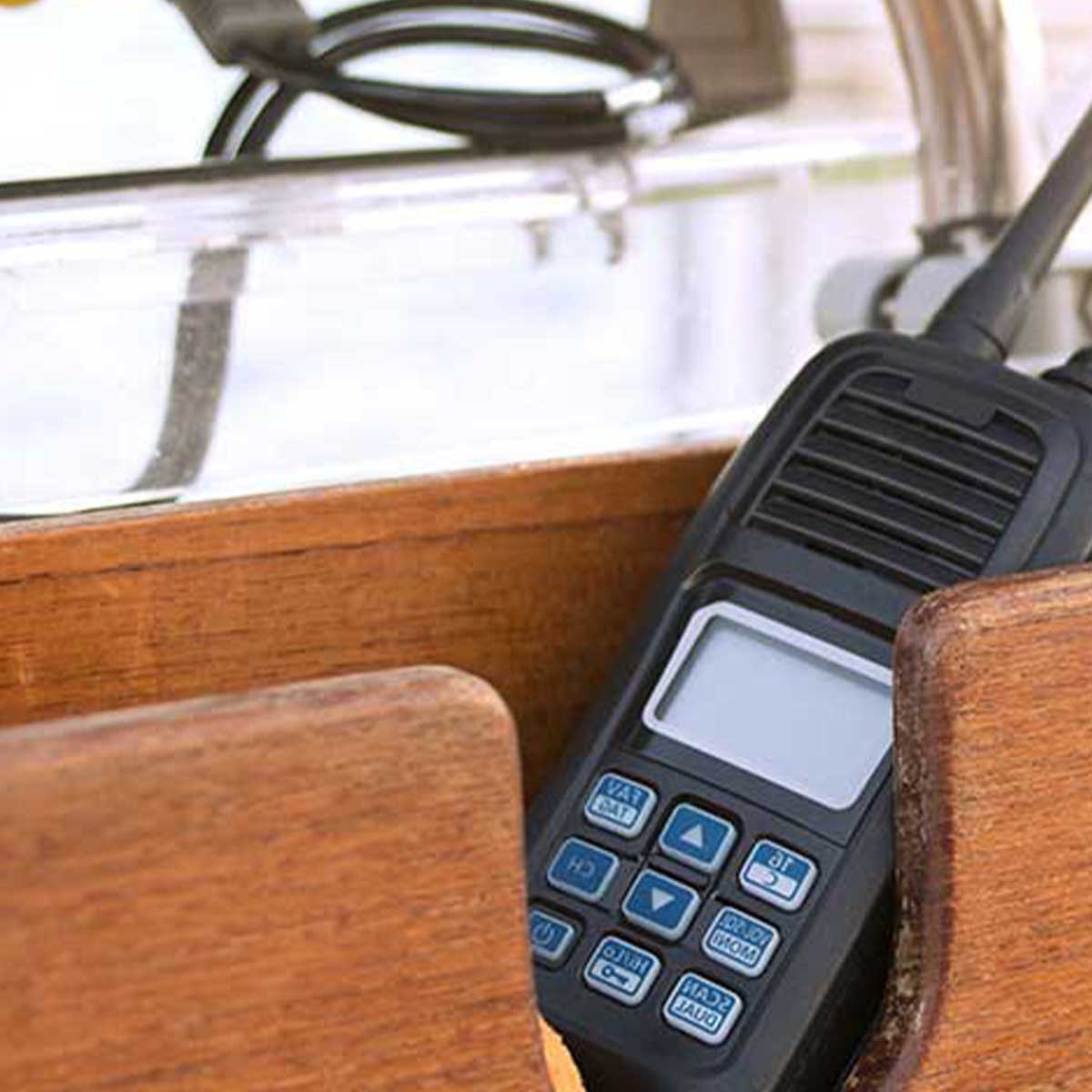
Le guide d'achat des VHF portables
Obligatoire, ou facultative, selon votre programme de navigation, la VHF marine portable est, quoi qu’il en soit, un élément de sécurité important sur votre bateau. Des plus basiques aux plus performantes, avec ou sans ASN, GPS ou AIS, indépendante ou couplée à la VHF fixe ; les modèles et les déclinaisons foisonnent, nous laissant devant un choix pléthorique, mais pas toujours évident à déchiffrer.
Nous allons, dans ce guide, tenter de vous aiguiller, de vous informer et de vous aider à choisir votre future VHF portable.
Qu’est-ce qu’une VHF marine portable ? Que dit la réglementation sur la VHF ? Quels avantages possède une VHF portable ? Quelles sont les différentes options que proposent les radios portables ? Quelle VHF portable est la plus adaptée à votre utilisation et vos besoins ?
Autant que questions que nous tenterons d’éclairer ici.
Qu’est-ce qu’une VHF marine portable ?
VHF portable avec technologie ASN
Qu’est-ce que l’ASN et le numéro MMSI ?
L’utilisation d’une VHF avec ASN (Appel Sélectif Numérique) est soumise à l’obtention du permis plaisance ou du CRR, nous reviendrons plus amplement sur ces obligations légales.
Une VHF, portable ou même fixe, disposant de la technologie ASN, doit être associé à un numéro MMSI (Maritime Mobile Service Identity). Ce numéro, délivré par l’Agence Nationale des Fréquences (ANFR), est unique à chaque bateau et permet une identification rapide du navire et de son propriétaire. Souvent couplé à un GPS, l’ASN réduit drastiquement le temps d’intervention des secours en leur transmettant des données précises.
Un bouton situé sur l’appareil (souvent rouge et sérigraphié « Distress ») permet d’adresser directement un signal de détresse aux autorités maritimes ou aux navires et bâtiments à proximité, équipés d’un récepteur.
Cependant, ce système ne se limite pas qu’aux appels de secours, il permet aussi de communiquer directement avec un autre bateau dont vous connaitrez le MMSI. Vous pourrez alors entrer directement en contact avec lui et lui envoyer des messages, à l’instar d’un téléphone. Vous aurez également la possibilité de récupérer sa position, son cap, son allure… Ces données pourront ensuite être lues sur votre lecteur de carte ou PC portable.
Vous aurez bien compris que ce numéro MMSI est lié à un seul bateau. Vous n’utiliserez donc votre VHF portable qu’avec ce seul bateau. Inutile de l’embarquer à bord du voilier de votre voisin, de la frégate rapide de votre belle-sœur ou du semi-rigide de pêche du petit dernier. Ce serait prendre un risque de communiquer au secours en mer des données erronées en cas d’avarie ou de naufrage.
Comment coupler sa VHF portable avec son numéro MMSI ?
À la réception de votre nouveau matériel, vous trouverez un formulaire à adresser à l’ANFR, seule habilitée à vous attribuer ce numéro d’identification. Vous entrerez ensuite ce numéro dans votre VHF.
Si votre bateau est déjà identifié avec ce MMSI, il vous suffira de l’enregistrer dans votre nouvelle VHF.
Si vous souhaitez changer ce numéro (parce que vous achetez un nouveau bateau, ou que vous faites l’acquisition d’une VHF d’occasion), c’est au constructeur de procéder à cette manipulation et non pas à vous.
Toutefois ce numéro MMSI peut être partagé par plusieurs VHF sur un même bateau. Votre VHF portable est, dans ce cas-là, connectée à votre VHF fixe. Les deux fonctionneront de concert. Très utile lorsqu’il faut, par exemple, rester à la barre, pour communiquer avec d’autres passagers ou encore rester en contact avec les occupants de votre annexe.
Les meilleures VHF portables avec ASN
VHF RT 420 DSC MAX
La RT420 DSC MAX de Navicom est une VHF Portable étanche IPX8 et flottante. Elle offre une puissance de 6W, un écran LCD rétro-éclairé et une batterie lithium polymère 4000mA. Elle est dotée d’une antenne VHF bateau GPS intégrée et fonction DSC (ou ASN) permettant de lancer une alerte en cas de nécessité.
VHF HX890E
La HX890 de Standard Horizon est une VHF portable performante avec GPS intégré. Avec un grand afficheur et des touches simples. C’est une VHF fiable, complète et flottante doté de la fonction ASN. Menu uniquement en Anglais.
VHF IC-M94DE
L’IC-M94DE est la première radio portable qui offre aux utilisateurs de recevoir des informations diffusées par d’autres navires équipés d’AIS. Autonomie de 10 heures. Puissance de sortie RF de 6W. Récepteurs ASN et GNSS intégrés.
Quelles sont les caractéristiques d’une VHF portable ?
La batterie et l’autonomie
Une VHF portable est soumise à une autonomie restreinte qui devra être prise en compte lors du choix de celle-ci.
Cette autonomie n’est pas un véritable problème, si tant est que vous disposiez d’un point de charge en 12V sur votre embarcation. Avec des batteries allant, approximativement, de 1000 mAh jusqu’à 2000 mAh, vous pourrez espérer, selon les modèles, une autonomie entre 8 et 20 heures. Les technologies de batteries Lithium-Ion et Li-Polymère sont majoritairement employées ici.
Tout comme votre téléphone portable, ou votre appareil électronique, vous devrez veiller à charger votre VHF portable avant votre sortie, et surveiller son niveau de charge, tout en optimisant son utilisation.
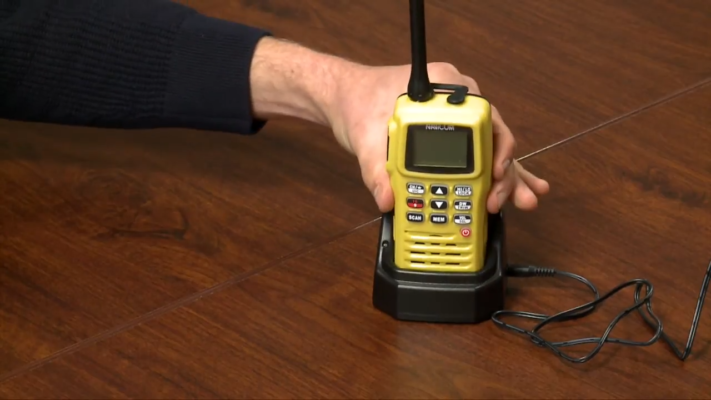
Flottabilité et Indice d’étanchéité
L’immense majorité des VHF portables marines présentes sur le marché sont étanches. Cependant leur niveau d’étanchéité varie selon les modèles. Un indice d’étanchéité normé, ou indice de protection d’enveloppe (IP) permet de les distinguer. Concernant les produits qui nous intéressent ici nous irons de l’IPx5 à IPx8.
- IPx5 : Protégé contre les jets d’eau de toutes directions, ainsi que les poussières et autres résidus microscopiques.
- IPx6 : Protégé contre les forts jets d’eau de toutes directions, et totalement protégé contre les poussières comme la Navicom RT411.
- IPx7 : Protégé contre les effets de l’immersion temporaire, jusqu’à 1 m, pendant 30 min.
- Ipx8 : Matériel submersible au-delà de 1 m dans les conditions spécifiées par le fabricant en durée et en pression4. Normalement, cela signifie que l’équipement est hermétiquement fermé, cependant, avec certains types de matériel, cela peut signifier que l’eau peut pénétrer, mais sans produire d’effets nuisibles.
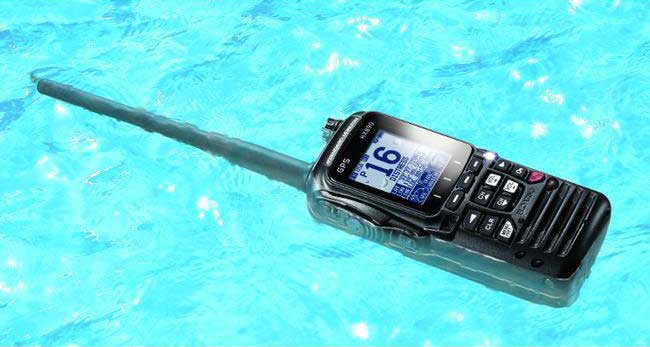
Dans un autre cas de figure, si vous naviguez en jet-ski, les risques d’éclaboussures et d’immersion sont plus grands. Il vaut mieux, alors, que votre matériel soit parfaitement étanche.
De la même manière, vous devrez choisir entre une VHF portable flottante ou non. Les mêmes exemples peuvent illustrer ce point. Or vous constaterez que, pour qu’une VHF flotte, il faut optimiser son poids. La meilleure façon de procéder est d’opter pour une batterie plus légère. Une batterie plus légère aura également une autonomie moindre. Nous pouvons en conclure que la flottabilité nuit à l’autonomie. CQFD.
Vous pourrez tout de même équiper, dans un second temps, votre VHF portable d’une pochette flottante si celle-ci ne l’est pas.
Notez que certaines VHF marines portables peuvent être couplées à un système « homme à la mer » (ou MOB) et déclencher des alarmes, y compris aux secours (CROSS, SNSM …) ou à l’équipage, dans le cas où un membre passe par-dessus bord.
Les meilleures VHF portables étanches et flottantes
VHF IC-M25EURO
La IC-M25EURO de Icom est une VHF portable étanche et flottante d’une puissance de 5W. Elle dispose d’un écran LCD et elle est équipée du système AquaQuake pour une étanchéité totale du dispositif.
VHF HX890E
La HX40E de chez Standard Horizon est une VHF portable et flottante, étanche ultra performante. Elle est équipée d’un large écran avec un affichage Dot Matrix très visible, rétro-éclairé et très lumineux. Vous pouvez accéder à toutes les fonctions simplement et rapidement grâce à son menu « E2O » (Easy to Opérate).
VHF IC-M94DE
L’IC-M37E de Icom est une VHF portable flottante de 6 Watts permettant de communiquer rapidement sur un canal au choix. Equipée du système AquaQuake et d’un grand afficheur c’est une VHF robuste et très performante.
Que dit la législation concernant les VHF ?
Les prérequis à l'utilisation d'une VHf
La VHF fixe, couplée à une VHF portable étanche, est obligatoire pour la navigation hauturière (au-delà de 60 milles d’un abri). La VHF fixe est également obligatoire en navigation semi-hauturière (entre 6 et 60 milles d’un abri).
En navigation côtière (entre 300m et 6 milles), le système radio n’est obligatoire que sur les engins à propulsion humaine (kayak de mer, pirogue polynésienne…), ou les bateaux de location.
D’après la documentation du Ministère de la Transition Écologique et Solidaire, l’usage d’une VHF portative d’une puissance maximale de 6 watts sans ASN ne demande aucune qualification spécifique obligatoire, dans les eaux territoriales et intérieures françaises.
Une formation telle que le CRR (Certificat Restreint de Radiotéléphonie), ou le permis plaisance, permet l’accès aux VHF avec ASN et à la navigation hors des eaux territoriales françaises. Ces qualifications offrent un gage de sécurité supplémentaire lorsque vous décidez de prendre la mer.
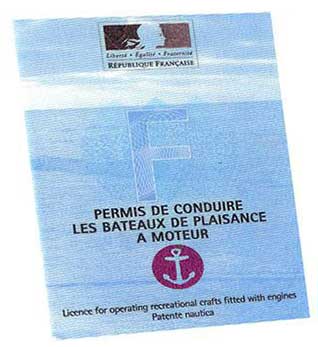
QUALIFICATIONS et PERMIS
La législation sur l’utilisation de la VHF en quelques points * :
- Pour l’utilisation d’une VHF portative d’une puissance maximale de 6 watts sans ASN, aucune qualification spécifique n’est exigée.
- Pour l’utilisation d’une VHF portative ASN ou d’une VHF fixe, avec ou sans ASN, de plus de 6 watts, des connaissances théoriques et pratiques nécessaires pour l’utilisation de la VHF sont intégrées dans le programme de formation ainsi qu’à l’examen du permis de conduire de bateaux de plaisance.
- Le titulaire du permis plaisance peut ainsi manœuvrer une VHF, fixe ou portable, dans les eaux nationales maritimes ou intérieures sans avoir à passer un examen supplémentaire. L’examen théorique pour l’obtention de l’option côtière ou de l’option eau intérieure de 30 questions intègre des questions sur la VHF.
- Les personnes non titulaires du permis plaisance restent soumises à l’obligation de posséder un CRR. Pour informations et formalités d’inscription, contacter l’Agence nationale des fréquences.
- Vérifiez que votre VHF est correctement initialisée et connectée au GPS. Dans les eaux intérieures françaises, l’utilisation de l’ASN est interdite.
Des utilisations diverses
EMBArCATION SANS MOTEUR
La VHF étant obligatoire pour toute embarcation à propulsion manuelle au-delà de la bande des 300 m, il nous a semblé judicieux de vous rappeler que de tels dispositifs vous seront utiles dans d’autres contextes que sur un voilier de plaisance ou un bateau à moteur.
Que vous pratiquiez le kayak de mer, le canoë, l’aviron, le stand up paddle (SUP) ou la pirogue polynésienne, vous devrez obligatoirement vous équiper d’une VHF, en plus d’un dispositif individuel de flottaison et d’un dispositif lumineux.
Vous trouverez également un usage à la VHF portable dans le cadre d’autres activités ou sports maritimes : la voile légère (catamaran, dériveur…), le kitesurf, le kitefoil downwind, le windsurf ou le wingfoil. La VHF pourra vous être d’une grande utilité en cas d’urgence, afin de prévenir au plus tôt le CROSS local ou la SNSM ou simplement vérifier la météo à venir.
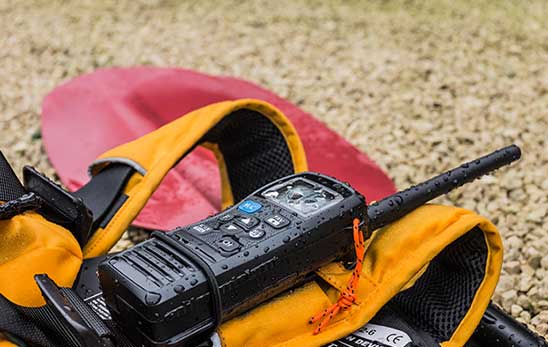
La VHF marine portable chez Comptoir Nautique
le spécialiste de l'électronique marine
Comptoir Nautique, spécialiste et numéro un européen de l’électronique marine, a mis à votre disposition une sélection de VHF portables dans différentes gammes de prix et répondant aux besoins de chacun. Vous y trouverez très certainement le produit qui vous conviendra, et toujours au meilleur prix. Ne manquez nos accessoires pour VHF également disponible, vous retrouverez des support, cables de recharge VHF et cable de liaison en tout genre ainsi que des antennes de rechange par exemple pour de nombreux modèles de VHF portable.
Nos conseillers sont disponibles pour répondre à toutes vos questions techniques, mais aussi les questions concernant le stock disponible ou les délais de livraison.
Que vous naviguiez en voilier habitable, en bateau à moteur, en semi-rigide ou en stand up paddle, la VHF portable sera votre fidèle allié sécurité.

